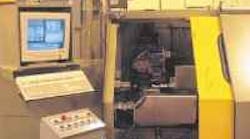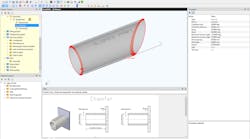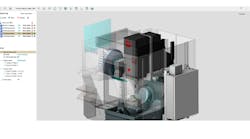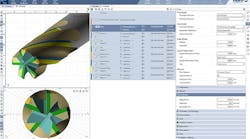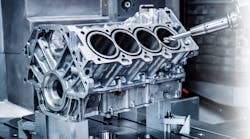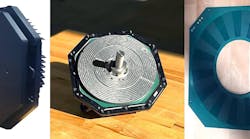Software-based CNC provides data in real-time without operator intervention.
Retrofitted with OpenCNC from MDSI, this 4-axis lathe can now be linked to a factory network while machining parts. It can also download part programs and collect machine data in real-time. Data can be displayed at the operator station or sent over a network to a spreadsheet program, database system, or machine maintenance program.
MDSI's OpenCNC software on Microsoft Windows NT allows the operator to download CAD drawings directly from factory networks. In this application AutoCAD Viewer is being used on OpenCNC.
OpenCNC software on Windows NT lets operators integrate third-party technologies like CimWorks GageTalker's VisualSPC software.
For the most part, proprietary CNC systems on the market today only focus on controlling the machine tool. They don't take the next logical step of collecting and distributing the information generated because the technology on which the CNCs are built doesn't allow for this critical sharing of data across the enterprise. Therefore, tracking of critical information is still done via operator intervention with machinists writing down a notation or manually inputting information into a keypad linked to a closed system which is not available enterprise-wide.
For machine-control systems to reach their potential as "manufac-turing data centers," they must adhere to an even higher standard of openness. The facilities for collecting data from the machine tool and making it available to higher-level manufacturing or business information systems must be intrinsic to the control system. Data collection and distribution can't be an appendage to the control relying on another PC, an operator, and manual input. Data re-entry on the factory floor is just as time-consuming, unproductive, and prone to error as it is in the office environment. And it doesn't provide real-time data.
In few other industries is access to real-time data more important than in the manufacturing industry. Process industries have the ability to monitor their manufacturing systems on a real-time basis. But their brethren in the discrete manufacturing industries have had to suffer through post-mortem analyses of why a machine failed, production volumes slipped, or a machinist did a feedrate override. A factory can't remain competitive and agile if data is not immediately available for making critical decisions.
Measuring and managing data
The goal with real-time data is simply better information on a more timely basis. Accurate, timely information helps companies make good decisions and improve upon them as they go, with the ultimate goal of saving money, improving bottom-line results, and satisfying customer needs.
In fact, the manufacturing process needs to be more integrated. Information generated at the machine tool can't be separate from the rest of the enterprise if U.S. companies are going to compete on a global basis. And central to the idea of integration is open architecture that allows accessible, real-time data. The object is to have the machine control not only tell the machine how to run, but also make the information available enter-prise-wide to better manage the manufacturing process.
The network is the factory
In order for manufacturers to access information from all machine tools, they need to find a cost-effective solution to upgrade machines with the technology to capture data at existing machines as well as new machines. One solution is OpenCNC from MDSI, Ann Arbor, Mich. OpenCNC is not a PC front-end, and it doesn't use a motion control card, both of which still are proprietary systems. It is a true software-based CNC. It runs on Microsoft Windows NT, providing real-time data on the manufacturing process without operator intervention. OpenCNC also allows access to real-time data on demand from anywhere in the enterprise and actually makes the machine tool an on-line peripheral on the network.
Great Lakes Industries of Jackson, Mich., a maker of gears and sprockets for companies such as John Deere, retrofitted its first CNC lathe with OpenCNC. "Be-fore we installed OpenCNC, if a machine failed or production was lower than anticipated, we tried to interpret information after the fact about what had happened," says Don Werner, vice president and general manager. "But it was just a stab in the dark because of all the variables. Now, we can track the machine cycle, including flip time and idle/loading time. A major variation is apparent immediately." He points to an example on the company's second shift, where idle time was inordinately high. "We were able to see the process flow as it was happening and learn that a new employee was not only taking longer to reload a machine, but he was also actually running the machine in a different sequence from the other shifts. We quickly caught the error, which highlighted a weakness in our employee training program. The cost savings have been significant," states Werner.
The company realizes machine controls can become collectors of critical manufacturing information, such as cycle times, feedrates, setup and inspection times, and capacity utilization.
Yet, despite the success some manufacturers have had with software CNCs, along with the call for a move to open systems, software-based controls remain an untapped asset.
Open systems mean better sharing of information across the enterprise, which ultimately benefits all manufacturers. Cim-Works GageTalker, a producer of manufacturing data-collection systems, has recently teamed with MDSI to develop an interface to bring even more value to the data that OpenCNC produces.
"In essence, we're helping to turn raw data into information," said Eric Berg, president of Cim-Works GageTalker. "We access the data that is being generated by OpenCNC's patented technology, and place it in a graphical format to provide critical information needed by manufacturers."
The day is near when machine tools will be on-line peripheral devices, linked to a PC as easily as a laser printer. When a control upgrade is required, users will load the new version on the network server and distribute it to all the machines at once. Machines could be networked to MRP ERP, CAD/CAM, or executive information systems.
Imagine that whenever operators need a new part program or managers need updated process data, they just pull it off the network. Part programs could be continually upgraded through machine performance information automatically captured by the open controls. Managers could be automatically apprised of changes in machine-tool capacity and processes could be continuously measured for improvement.
"OpenCNC is both an information processor and a machine control," says Werner. "As it keeps the machine running, it provides information and the tools to extract the data that we want, from how many times an operator adjusts the offset, to how the bottleneck machine is performing, to how long the spindle is running over a 24-hr time frame. It has opened our eyes to what is going on in the process."
